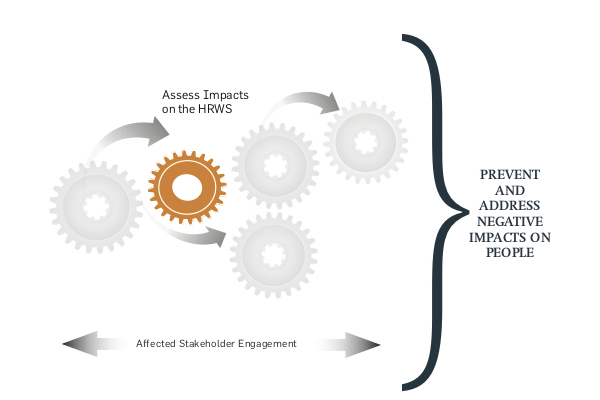
- In addition to understanding the company’s water-related risks from a business perspective, water stewards are increasingly expected to understand the risks that the company’s operations pose to affected stakeholders. A human rights lens clearly focuses attention on risk to people.
- Assessing impacts means gathering the information needed to understand a company’s actual and potential impacts on the HRWS. Meaningful engagement with affected stakeholders is essential to understand how the company’s operations may have negative impacts on people.
- Companies need to review their existing assessment systems to determine if they can be used to identify actual and potential impacts on the HRWS, and if not, how these functional gaps can be addressed.
- A human rights lens uses the severity of the impact on affected stakeholders to prioritize issues for attention by the company, where prioritization is necessary. Those impacts may be at a company’s own facility or elsewhere in its value chain.
A company should consider its various business activities and how they may negatively impact different stakeholders. The process should pay attention to individuals or groups who may be particularly vulnerable or marginalized.
Under the UN Guiding Principles, a company should consider three different modes of involvement — cause, contribution, and linkage — when assessing whether it is or may be involved with negative impacts on the HRWS.
A company should consider impacts arising through business relationships during the impact assessment process. Where it is necessary to focus on certain types of business relationships because of limited resources, a company should be guided by the severity of negative impacts involved, rather than focusing only on those relationships that are most important to the company.
To understand its impacts, a company should engage with affected stakeholders or their legitimate representatives as part of the assessment process. Where direct engagement is not feasible, companies should engage with credible proxies.
A company should assess the severity of an impact on the HRWS by considering its scale, scope, and the extent to which the harm involved can be remedied.
In addition to understanding severity of an impact on the HRWS, a company should under- stand the likelihood of it occurring or recurring.
Where it is not possible to address all HRWS impacts at once, a company should prioritize impacts for attention based on their severity and likelihood, with severity being the dominant factor.
A company should review whether its existing assessment processes provide it with the information it needs about impacts on the HRWS and address any gaps that may exist.
Cumulative impacts arise from parallel contributions by one or more actors that lead to a negative impact on the HRWS. Such impacts may be particularly severe and challenging to address. A company should ensure that its impact assessment processes adequately capture such cumulative impacts, so that appropriate action can be taken to address them in collaboration with other relevant actors, including the state.
| What are relevant business activities? |
| Relevant business activities include everything a business does in connection with the life cycle of its products or services, from the sourcing of components or commodities to its design, production, delivery and after-service. This includes hiring and/or contracting staff, contractors, suppliers, customers, governments, or others. Activities can include procurement, legal, compliance, sales, operations, human resources, R&D, among others. |
| What is linkage? |
| Linkage refers to the actions of a business partner or another entity in a company’s value chain that cause an impact that is directly linked to the company’s own operations, products, or services, which the company itself did not cause or contribute to.
In the context of corporate water stewardship, “direct linkage” may be similar to the concept of “indirect water use”; however, this Guidance uses the terminology of the UN Guiding Principles to ensure consistency with companies’ broader efforts to implement their responsibility to respect human rights. |
| What are customary water rights? |
| Customary water rights refer to rights over water use that are acquired or established by traditional patterns or norms within a particular sociocultural setting. Companies should consider these rights in a range of settings, but particularly where there are indigenous communities. |

